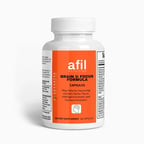Tordon 22k (Herbicide)
Tordon 22K contains picloram, a persistent herbicide that may cause fatigue, rashes, or breathing issues. Avoid for 8 weeks, support detox, and use organic alternatives.
🌿 What is Tordon 22K (Herbicide)?
Tordon 22K is a systemic herbicide with picloram, used to kill woody plants and weeds. Its persistence in soil and water may cause health sensitivities.
🤔 Why Do I Have a Sensitivity to Tordon 22K?
You likely have a sensitivity to Tordon 22K because your body sees its active ingredient, picloram, as a toxin—and your system may not be clearing it efficiently. Here's why that can happen:
- Your detox pathways may be sluggish – If your liver, kidneys, or cellular detox systems (like glutathione production) are under-functioning, even small amounts of chemical exposure can build up and cause symptoms like fatigue, rashes, or breathing issues.
- You have heightened immune reactivity – Your immune system might be hypersensitive and overreacts to foreign chemicals, treating them as threats and triggering inflammation.
- Picloram is persistent – It sticks around in the environment (soil, water, air), meaning you might be getting small exposures even if you’ve never used it directly.
- You may have a history of chemical exposure – Prior contact with pesticides or similar toxins can "prime" your system to react more strongly later.
- Genetic predispositions – Some people have genetic variations (like in MTHFR or GST enzymes) that reduce their ability to break down environmental toxins.
🛠️ What Can I Do About It?
-
🚫 Avoid exposure for at least 8 weeks—stay away from treated areas and contaminated surfaces
-
🌱 Switch to organic or untreated products in your home, yard, and food
-
🧼 Detox your environment—wash clothes, clean surfaces, and ventilate indoor spaces
-
🍋 Support liver detox with nutrients like glutathione, NAC, milk thistle, and vitamin C
-
🛡️ Boost immune resilience through anti-inflammatory foods, sleep, and stress management
-
🌀 Use air and water filters to reduce daily chemical load
-
🚿 Rinse off after outdoor exposure and wash clothes separately
💊 Which Supplements Can Help with Tordon 22K Sensitivity?
- Glutathione – Essential for detoxing persistent herbicides and protecting cells from oxidative damage.
- NAC (N-Acetyl Cysteine) – Boosts glutathione and supports respiratory and liver function.
- Milk thistle – Strengthens and protects the liver from chemical overload.

- Vitamin C – A natural antioxidant that helps reduce inflammation and support immune balance.

- Selenium – Supports thyroid health and neutralizes oxidative effects from chlorinated herbicides.

🌟 Why Might I Have a Sensitivity to Tordon 22K Even Though I Don't Use It?
You may be reacting to indirect exposure or underlying chemical intolerance, such as:
-
Environmental drift – Picloram can travel through air, water, or soil from nearby treated areas
-
Residue transfer – You might come into contact via shoes, pets, tools, or clothing from treated zones
-
Contaminated water or soil – Tordon 22K is persistent and may linger in the environment
-
Past exposure buildup – Previous contact may have primed your body to react, even to tiny amounts
-
Impaired detox pathways – If your liver or cellular detox systems are sluggish, even low-level exposure can cause symptoms
-
Chemical sensitivity – Some people react to very small amounts of synthetic chemicals, especially if they have a history of sensitivities or chronic inflammation
‼️ Common Exposure Sources:
-
Rangelands, pastures, and roadsides treated for invasive plant control
-
Airborne drift from nearby spraying (especially on windy days)
-
Contaminated soil or dust tracked indoors via shoes, pets, or equipment
-
Surface runoff into nearby gardens, lawns, or water systems
-
Residue on clothing, tools, or vehicles used in treated areas
-
Compost or mulch made from treated plant material
✅ Alternatives (if tolerated):
-
Manual removal (dig out unwanted plants)
-
Boiling water for small weed patches
-
Vinegar, salt, and soap spray (DIY herbicide)
-
Mulching to block weed growth
-
Flame weeding (use with care and proper equipment)
-
Avenger Weed Killer (citrus-oil-based)
-
Green Gobbler (vinegar-based, non-toxic)
-
Doctor Kirchner (vinegar, ocean water, and soap blend)
-
EcoSMART (plant-based, pet-safe herbicides
.png?width=100&height=75&name=AFIL%20Logo%20(1).png)